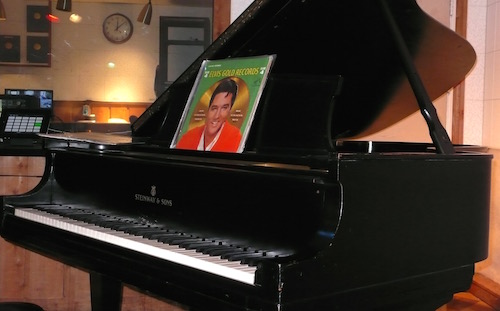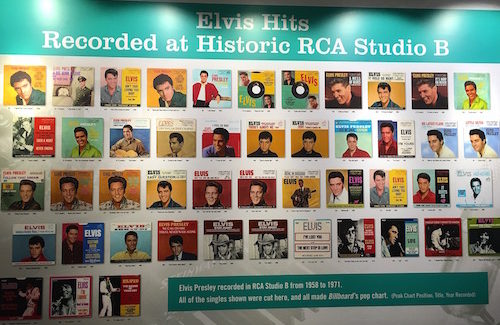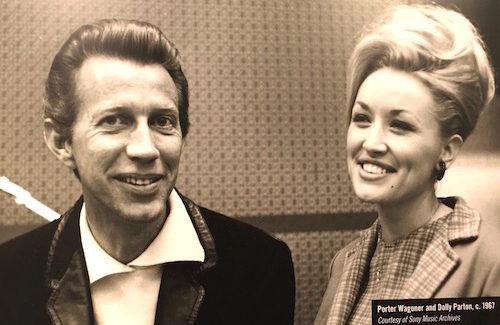Visiting Nashville: Known as ‘Home of 1,000 Hits,’ Studio B was a Favorite of Elvis and Other Musicians
While most people were settling down for the night, Elvis Presley would slip into the nondescript building and sit at a well-worn piano.
For the next couple hours, Elvis would warm up by harmonizing on gospel, often with the Jordanaires. Then he would get down to the serious business of recording songs. About the time the sun came up, Elvis would call it a night.
“Elvis did most of his work here. He recorded 262 songs here, almost 70 percent of his entire songs,” said tour guide Stephanie Lane. “Elvis was in here more than any other artist … He once recorded 12 songs in 12 hours. He was amazing.”
Known as the “Home of 1,000 hits,” historic Nashville RCA Studio B is located on 17th Avenue on Music Row. The studio was built for $37,515 at the request of Chet Atkins and Steve Sholes for the RCA Victor record label. In his autobiography, Atkins said the studio plans were drawn up on a napkin.
Opened in November 1957, Studio B is a simple single-story building. The area of the studio and control room has a second story that contains an echo chamber. “They called it Studio B because there was also a Studio A,” Lane said.
Not beautiful by any stretch of the imagination, Studio B was known for its distinctive acoustics. The walls were designed in an accordion shape changing angles every four feet to make the room as “dead” as possible. The walls are covered in 1-foot-square acoustic tiles all the way to the ceiling beginning three feet from the floor.
“Normally you see carpet in a recording studio, but they used tile here,” Lane said. “The sound would bounce naturally throughout the room. It had an excellent natural sound.”
Elvis’ first Studio B session was June 10, 1958, and his last on June 10, 1971. Those sessions yielded a string of top hits including “How Great Thou Art,” “A Big Hunk of Love,” “It’s Now or Never,” “Crying in the Chapel,” “Little Sister” and “(You’re the) Devil in Disguise.” He also used Studio B to record the soundtracks for many his movies.
“Elvis had the lights put in the ceiling for atmosphere,” Lane said, gesturing to the red, blue, green and white lights. “But when he recorded ‘Are You Lonesome Tonight,’ Elvis had them turn off all the lights. It was pitch black in here. Only six people, two guitars and the Jordanaires singing backup. Elvis did that song all in one taping.”
Initially, Chet Atkins would try to attend Elvis’ recording sessions. But Chet couldn’t stay up all night like Elvis so he’d usually just come in, say hello and go home to bed while they recorded all night.
CREATING THE NASHVILLE SOUND
Studio B’s fame rests not only on the many hits recorded here, but also on its role in creating what came to be known as the Nashville Sound. By the time the studio opened, rock ’n’ roll’s popularity had drawn many young fans away from country music. In response, Atkins and other Nashville producers and engineers experimented with making records in a smooth, pop-oriented style aimed at an adult audience.
The sophisticated Nashville Sound lessened the use of steel guitars and fiddles, adding mellow strings and vocal choruses.
A subtle difference in the bricks on the building’s exterior is a reminder of Dolly Parton. The story goes that she was so excited to be recording at the studio and so thrilled to be driving a new car that she accidentally ran into the building.
“Dolly always joked that was her first big hit,” Lane said.
In 1977, RCA closed Studio B. “Elvis died on August 16, and Studio B closed its doors the day after,” Lane said. “The studio didn’t close because of Elvis’ death but because of a union conflict.”
A few years later, the studio was donated to the Country Music Hall of Fame and Museum. RCA donated the studio’s equipment. In 2002, Studio B became part of a partnership with the Curb Family Foundation and the Country Music Hall of Fame and Museum.
Today, Studio B is a tourist attraction, as well as a working studio. Tours of Studio B depart daily from the County Music Hall of Fame and Museum. Visitors board a small shuttle bus for the ride to and from Studio B with narration by a tour guide.
A video at Studio B shows some of the greats who recorded there. Hitmakers include Eddy Arnold, Waylon Jennings, Bobby Bare, Dolly Parton, Jim Reeves, Floyd Cramer, Charley Pride, Porter Wagoner, Perry Como, Everly Brothers, Roy Orbison, Rosemary Clooney and Barbra Streisand.
“All the equipment here is original. That’s probably the most important piano in music,” Lane said, gesturing to a well-worn Steinway Grand. Once played by Elvis and Floyd Cramer and others, the piano bears the scratches and scuffs from years of use.
“More than 35,000 songs were recorded here,” Lane said. “You’re walking on history when you come to Studio B.”
Story and photos by Jackie Sheckler Finch

















View Recent Comments